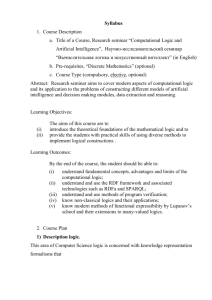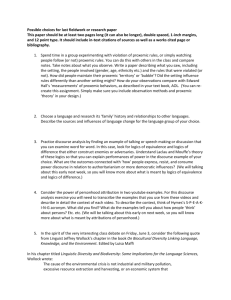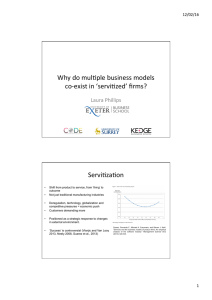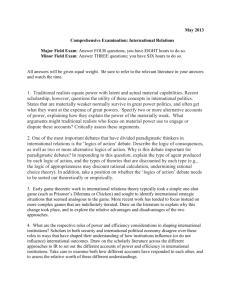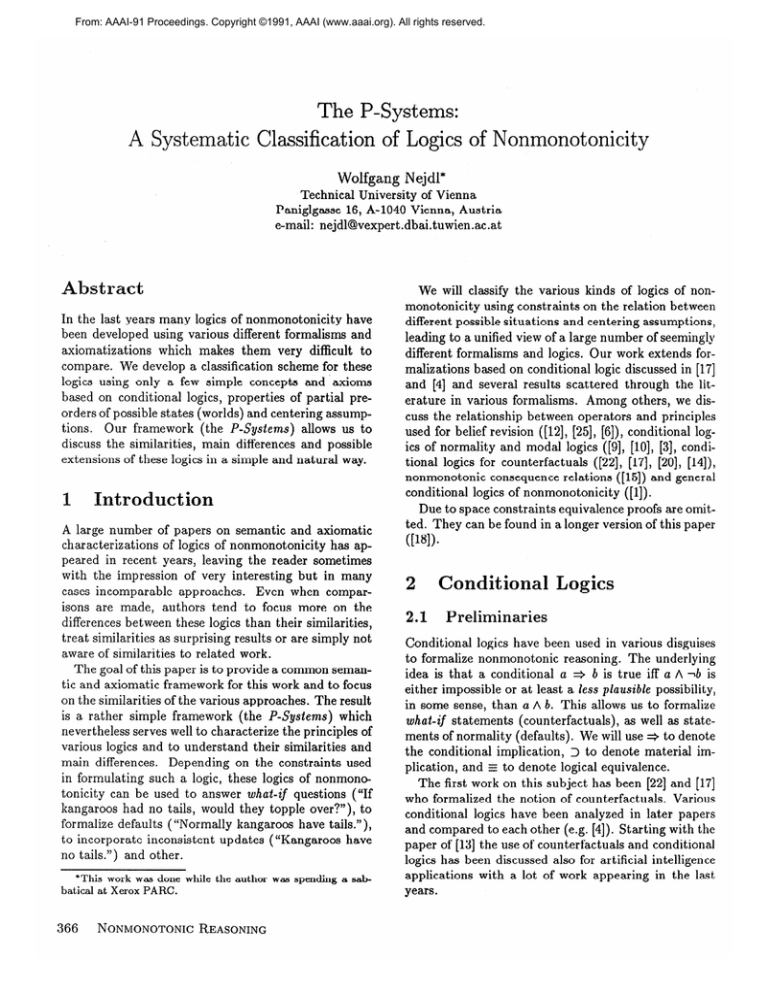
From: AAAI-91 Proceedings. Copyright ©1991, AAAI (www.aaai.org). All rights reserved.
The P-Systems:
A Systematic Classification of Logics of Nonmonotonicity
Wolfgang Nejdl*
Technical University of Vienna
Paniglgasse 16, A-1040 Vienna, Austria
e-mail: nejdl@vexpert.dbai.tuwien.ac.at
Abstract
In the last years many logics of nonmonotonicity have
been developed using various different formalisms and
axiomatizations
which makes them very difficult to
compare. We develop a classification scheme for these
logics using only a few simple concepts and axioms
based on conditional logics, properties of partial preorders of possible states (worlds) and centering assumptions. Our framework (the P-Systems) allows us to
discuss the similarities, main differences and possible
extensions of these logics in a simple and natural way.
1
Introduction
A large number of papers on semantic and axiomatic
characterizations of logics of nonmonotonicity has appeared in recent years, leaving the reader sometimes
with the impression of very interesting but in many
ca#ses incomparable approaches. Even when comparisons are made, authors tend to focus more on the
differences between these logics than their similarities,
treat similarities as surprising results or are simply not
aware of similarities to related work.
The goal of this paper is to provide a common semantic and axiomatic framework for this work and to focus
on the similarities of the various approaches. The result
is a rather simple framework (the P-Systems) which
nevertheless serves well to characterize the principles of
various logics and to understand their similarities and
main differences. Depending on the constraints used
in formulating such a logic, these logics of nonmono
tonicity can be used to answer what-if questions (“If
kangaroos had no tails, would they topple over?“), to
formalize defaults (“Normally kangaroos have tails.“),
to incorporate inconsistent updates (“Kangaroos have
no tails.“) and other.
*This work was done whilethe author was spendinga sabbaticalat Xerox PARC.
366
NONMONOTONICREASONING
We will classify the various kinds of logics of nonmonotonicity using constraints on the relation between
different possible situations and centering assumptions,
leading to a unified view of a large number of seemingly
different formalisms and logics. Our work extends formalizations based on conditional logic discussed in [17]
and [4] and several results scattered through the literature in various formalisms. Among others, we discuss the relationship between operators and principles
used for belief revision (1121, [25], [6]), conditional logits of normality and modal logics ([9], [lo], [3], conditional logics for counterfactuals ([22], [173, [20], [14]),
nonmonotonic consequence relations ([ 151) and general
conditional logics of nonmonotonicity ([l]).
Due to space constraints equivalence proofs are omitted. They can be found in a longer version of this paper
wo
2
2.1
Conditional
Logics
Preliminaries
Conditional logics have been used in various disguises
to formalize nonmonotonic reasoning. The underlying
idea is that a conditional a j b is true iff a A lb is
either impossible or at least a less plausible possibility,
in some sense, than a A b. This allows us to formalize
what-if statements (counterfactuals),
as well as statements of normality (defaults). We will use a to denote
the conditional implication, > to denote material implication, and f to denote logical equivalence.
The first work on this subject has been [22] and [17]
who formalized the notion of counterfactuals.
Various
conditional logics have been analyzed in later papers
and compared to each other (e.g. [4]). Starting with the
paper of [13] the use of counterfactuals and conditional
logics has been discussed also for artificial intelligence
applications with a lot of work appearing in the last
years.
For sake of simplicity we discuss only the case of
propositional logics, although some of the logics have
been extended to first-order.
Additionally, we concentrate on theorems containing only unnested occurrences of =+ as most logics can only handle this case.
We neglect small differences between two logics if
they are only caused by the different formalisms used
although the logics share the same model-theoretic
princip1es.l We think this approach is justified in order
to stress the common properties of these logics which
have not been obvious in many recent papers.
2.2
Normal
Conditional
Logics
We start by describing a very basic conditional logic
called CK which has been axiomatized in [5]. Although
all our remaining logics are more restricted than CK,
CK is useful to characterize the common properties
of the logics of nonmonotonicity discussed in section 3.
All logic systems we discuss obey additional constraints
and are formalized simply by extending the axioms
valid in CK.
For CK we consider a semantic model M =
(IV, f, P), where f is a mapping that selects a set of
worlds f(w,A) f or each world w E W and proposition
A E P. For such a wff A, ljAllM stands for the set of
worlds in M in which A is true. To evaluate a conditional A + B at a world T.Uin a model M we use
l=f A * B iff f(w, 4 c llBllM
We do not include any constraints on f(w, A), except
that it only selects worlds in which A is true, i.e.
fb44
E l141M
Assuming that this definition of f defines a notion
of plausibility and selects the most plausible worlds in
which A is true, we may paraphrase it by
A + B is true at w if B holds in all most
plausible A-worlds for zu as selected by f.
This very basic logic CK can be defined by the following two basic inference rules:
ArB
(RCEA)
(RCK)
(A + C) s (B * C)
(B1 A -- -AB,)>C
((A =+ B1) A -~(A=sB,))>(A*C)
Similar rules have been used in axiomatizations of
other conditional logics compared in this paper. They
l An examplewould be the differencein expressiveness
betweenthe lo&s describedin [3] and thosein [15].
can be derived in CK:
B,C
(RCEC)
(A =+ B) = (A 3 C)
(RCM)
(A 3 B) I (A =+ C)
B3C
(BAC)+D
(RcR)
((A + B) A (A =+ C)) 3 (A + D)
In [15], RCEA corresponds to left logical equivalence,
RCK to right weakening.
Similarly, some axioms used in various logics of nonmonotonicity are already theorems in CK.
CC
CM
(A*B)A(A+C)>(AS-BAC)
(A*(BAC))>((A=SB)/I(A+C))
In [15], CC corresponds to und. As all logics in [15]
already contain RCEA and RCK, and is redundant
in their axiomatization.
Logics including only RCM
instead of RCK have to include CC as axiom. If we
use RCEC instead of RCM, we also have to include
CM. In [4] CC corresponds to Al and CM to Ad.
Additionally, the rule Mp (modus ponens) is valid for
>, as well as all truth-functional tautologies of prop*
sitional calculus (PC).
It is possible (and in some cases useful) to define conditional logics which do not satisfy RCK (e.g. the logic
from [11], as axiomatized as the logic G in [19]). CC
and CM are not theorems of G, and the plausibility relation is dependent on both antecedent and consequent
of the conditional A a B. Although this is an interesting possibility, we will not discuss such logics in our
paper.
3
3.1
The
System2
The previous section has left open the specification of
the selection function f and thus the notion of how
to determine the plausible worlds. Building on [4], we
proceed by introducing a ternary plausibility relation
defining a partial pre-order on those worlds with respect to the current world.
We understand under a semantic model M the set
of all pairs (IV, R), with W an nonempty set of possible
states (or worlds) and R an ternary relation on it. For
x E W, W, = {y I3zRxyz).
Each state is labeled with a propositional model describing the facts at this state. Several states can be
labeled by the same model (see [15] for an example),
although this will usually not be the case. The relation
NEJDL
367
Rxyz may be interpreted by saying that from the point
of view of x, y is at least as plausible as Z.
The minimal requirements we place on the relation
.
R are reflexivity and transitivity:
V’z E W Vy E Wz Rxyy
‘ifx E w vyzw E W,: (Rxyz A Rxzw
> Rxyw)
R defines therefore a partial pm-order on the states
in W (which is local to each x E W). The selection
function f(x, A) can be defined as selecting the most
plausible worlds according to this partial pre-order R,
which is expressed by
f (x, 4
=
E ws I Y E I141MA
(Vz E WCn llAllM R=y ZI Rxyz)}
{Y
Our definition from section 2.2 is then equivalent to
the one used in [4], where A a B is true with respect
to a world x E W iff
‘fy E Ws n llAllM 3.z E Wz n IIAIIM :
(Rxw AVt E W,n llAllM (Rxtz > t E IIBIIM))
and can be paraphrased
as
A + B is true at x if B holds in all most
plausible A-worlds for x according to R.
For simplicity’s sake, we assume the limit assumption
as defined in [22] and [17] for infinite numbers of worlds.
This assumption basically forbids an infinite sequence
of ever more plausible worlds (i.e. wekfoundedness for
partial pre-orders). 2 For a finite number of worlds this
assumption is obviously valid. The smoothness condition defined in [15] is more general, but equivalent to
the limit assumption in our case (R being reflexive and
transitive).
To get a logic system corresponding to this definition,
we have to add the following three axioms to CK. We
call the resulting conditional logic System-P.
ID
ASC
CA
A+A
(A+B)A(A+C)r>(Ar\B+C)
(A=G)A(B%T)>(AVB=HT)
ID needs reflexivity whereas ASC needs transitivity.
CA reflects the fact, that each state is labeled exactly
with one model (in contrast to weaker logics defined in
PW.
logic S defined in [4].
2We will not presenta constrainton R, as well-foundedness
is onlysecond-orderdefinable.
368
3.2
SystemPc
We have said nothing about the actual world so far. Indeed, this is the crucial difference between conditional
logics used for evaluating counterfactuals and conditional logics of normality (or obligation).
Counterfactuals are evaluated with respect to the actual world. This is represented by so-called centerhg
axioms (see [17]). A ssuming weak centering the actual
world w is among the most plausible worlds for x, while
under strong centering w alone is the most plausible
world.
The difference between strong and weak centering
has been analyzed in [19]. Basically, strong centering
is assumed in minimal change theories, where only miuimal changes for accommodating a certain fact are assumed. In contrast, weak centering is used in small
change theories, which additionally allow small, nonminimal changes, if the difference to minimal changes
is negligible.
A good example are probability-based
systems using a cutoff based on the relative difference
to the most probable hypothesis (i.e. the cutoff criterion used in the model-based diagnosis system Sherlock
described in [8]).
Logics of normality (like System-PA, which will be
discussed in section 3.3) include these centering assumptions as plausible defaults, but do not enforce
them.
Strong centering is represented by the following constraint on the plausibility relation R:
Vx E W (x E W,AVy
Weak centering
straint
E WC (x # y 1 R~~y~lRxyx))
is represented
by the similar
VxEW(xEW,AVyEW,Rxxy)
System-P is equivalent to
o the minimal counterfactual
In [15], ID corresponds to reflexivity, ASC to cuutious monotony and CA to or. The axioms correspond
to All, A3, A4 in [4]. In [l], CA has been named AD.
Such a logic might be suitable for reasoning about,
morality or obligation, where we neither assume an absolute pre-order valid for all worlds nor that our world
is the most preferred one.
In the following sections we will add additional constraints to System-P which will be reflected in the subscripts of these logics (i.e. the name System-PMc will
be used for a logic extending System-P by modularity
and centering axioms).
NONMONOTONIC REASONING
The corresponding axioms included in System-PC
are
MP
(A + B) > (A > B)
CS
(Ar\B)>(A=>B)
where MP corresponds to weak centering, CS to strong
centering.
Conditional
logics for evaluating counterfactuals
equivalent to System-PC are based on the notion of
minimal change. A prominent example is
e the counterfactual
logic SS defined in [20].
The logic P from [15] is mistakenly compared to SS
in [lci]. This is not true, as P lacks the axioms for
centering. Let us note, however, that the presence or
absence of the centering axioms does not make any difference if we are only concerned with assertions of the
form A =G-B.
3.3
SystemA?~
Up to now, we have considered partial pre-orders of
states with respect to specific states. We might include
the assumption that the partial pre-order of states is
absolute (i.e. the same with respect to all worlds), represented by the following constraint:
vxw (Rx&z 3 Rwyz)
Having an absolute plausibility measure simplifies
things as we can use a global binary relation 5 to express preferences between different situations.
Absolute pre-orders are therefore useful for reasoning about
defaults and normality.
As we consider only non-nested theorems in this pa
per, we do not have to add additional axioms for absoluteness (see the following section 3.3.1). Thus, the
theorems of System-PA are the same as of System-P.
This is a welcome result, as a binary relation is easier
to handle and is also the basis for the Kripke semantics
used in modal logic.
Using this connection, we can show that System-PA
corresponds to
e the minimal logic of normality CT4 equivalent to
the modal logic S4 defined in [3], and to
e the logic of preferential
defined in [15].
consequence
relations
P
In CT4 each world ut can access all worlds z which
are at least as plausible as ‘~1,i.e.
x 5 w > wRax
where R, is the accessibility relation of modal logic.
This leads at once to the following definition of A + B
in terms of necessity and possibility used in [3]:
o(n-Av
O(Ar\
q (AIB)))
The definition formalizes the idea, that either A is false
in each plausible world, or A is true in some plausible
world w and in each world at least as plausible as w,
A 1 B is valid. This definition is therefore equivalent
to the one we used for defining the truth-value of the
conditional A a B.
The following weaker definition
q lAv
O(Ar\
q (A
xB))
which is mentioned in [3] amounts to checking this
formula only in the current world x. It is therefore
sufficient, that in some world wi reachable from x
(AA n(A > B)) is true, while it is false in another
reachable world wj.
So if the worlds accessible from x form two sets which
are not connected, we may get both (A A 0 (A 1 B))
and (AA 0 (A 1 -B)). Th is is why we can get absurd
results such as both A + B and A + 1B are true
(each being supported by another set).
3.3.1
Nested Theorems
As indicated in the last section, we do not need to add
additional axioms representing absoluteness, if we only
consider theorems, which do not contain nested occurrences of 3. We can express this by the following theorem, which can easily be proved given the definition
of *.
Theorem 3.1 All theorems containing unnested occurrences of =+, which can be expressed by a relational
principle on the ternary relation R can also be expressed by a relational principle on the binary global
relation 5.
Special nested theorems have to be expressed by index principles relating the view of different worlds. An
example for a nested theorem depending on such an
index principle can be found in [24] (formulated there
for a strict partial order). The absorption law
(A *
(B +
C)) > ((A A B) + 6)
is equivalent to the index principle
Vxyz (1Rxzy
> Vu Ryzu)
Unfortunately, this constraint is too strong to be of
much use.
Nested theorems of another sort (containing 3 as
the primary operator) are mentioned in [3]. CT4 (and
indeed all extensions of System-P containing no index
principles) include the theorems:
(A A (A + B)) j B
(A+C)=Q(AAB)aC)
NEJDL
369
The first axiom corresponds to the axiom for weak
centering and basically introduces Mp (modus ponens)
for 3. It is easy to show that it is equivalent to
(A 3 B) + (A > B)
which corresponds to a default assumption stating that
our world is as normal as we can possibly assume.
Strong centering can be transformed similarly into
(A A B) j
(A + B)
which expresses the fact, that we tend to generalize
j relations as much as possible using induction from
existing facts.
The second axiom mentioned in [3] corresponds to
the thesis strengthening antecedents valid for classical
logic. Indeed, even the versions of transitivity
and contraposition
SystemJcA
Assuming both centering and absoluteness,
t em,PcA equivalent to
l
the conditional logic
monotonicity in [11.
c, presented
we get sys-
SystemJ?Dc
Another possibility, which has not been explored much,
is to require a directed partial pre-order, where any two
elements have an upper bound.
Directedness can be expressed by the following constraint on R:
Vx E W kfyz E W, 3u (Rxyu A Rxzu)
370
NONMONOTONICREASONING
+ ‘B)
A ‘(T
=+ -A)
T + A can be read as “normally A” (as discussed
in [3]). U n der strong centering T + A is true, iff A is
true in the actual world w.
If we require directedness and centering, we get logits suitable for update semantics computing results of
changes to the actual world using set-theoretic minimality (which respects directedness), such as
o the update operator for reasoning about action described in [25].
3.6
System_lPDA
which
Model-based diagnosis systems using minimality in
a set-theoretic sense are special versions of the logic
described by System,PoA, such as
o MBD systems using the definition of diagnosis described in [7] and [21].
In this case, the “most normal” situation is the
empty diagnosis (everything is correct), so the axiom
CV’ does not help us much, if we want to use conditionals to describe the effects of faults (which are not
valid in the most normal state of affairs).
as logic of non-
However, it seems to us, that a general logic of
nonmonotonicity should not include centering axioms.
These are indeed basically made useless by the construction used in [l], where theorems are defined with
respect to minimal worlds. Therefore any logic corresponding to System-PA would probably be more suitable for this purpose than C.
3.5
(A + C) A -(A
>(AAB&?)
e C5!'4G, a logic of normality based on S4.2,
is mentioned in [3].
3 1A)
seem to be valid. So all these additional theses really
tell us is that “normally” we use classical logic. We
conclude, that nested theses of the form discussed in
[3] do not seem to contain much new information, but
are interesting for making these normality assumptions
explicit.
3.4
CV’
axiom is
Directedness has been first considered in [3], where it
has been combined with the constraint of absoluteness.
SystemJDA is therefore equivalent to
(A 3 B) A (B =+ C) 3 (A + C)
(A + B) + (‘B
The corresponding
3.7
SystemJ?Mc
A higher degree of monotony than in our previous logics
follows from the assumption that the plausibility relation ranks the possible worlds in disjunct levels of plausibility. This leads to a plausibility relation, where all
reachable situations are comparable, but where equally
plausible situations may exist.
This corresponds
to the constraint
of almostconnectedness of the relation Rxyr:
Vx E W Vyz E Wz (Rxyz v Rxay)
It is equivalent to the partial pre-order being mod&l
(as recognized in [13]), which we can also formalize by
Vxyz (x 5 Y) A (Y L x) A (% < 2) 3 (% < Y>
where (a < b) E (a 5 b) A (b g a).
This logic is strictly stronger than S?@e?n,PDc,
any modular pre-order is directed.
The corresponding axiom to almost-connectedness
the familiar axiom
CV
as
is
(A=d’)r\+A*lB)>(A/\B*C)
It is called rational monotonicity in [15].
If we assume almost-connectedness plus centering we
get some familiar conditional logics used for counterfactuals, as well as some other rational logics. Assuming
strong centering, we get
e the prototype of counterfactual
logic, VC of [17],
3.9
There is one more assumption we can add, and that is
the constraint of linearity of the plausibility relation,
which excludes ties between possible situations.
We then have
vx E w
CEM
(A*B)v(A+lB)
validating the rule of “conditional excluded middle”
well known from monotonic reasoning.
This logic is equivalent to
If we assume only weak centering we get the logic
e the first formally defined logic for counterfactuals,
C2, which is discussed in [22].
e VW, which also has been defined in [17].
System-PMC is one of the most monotonic system we can get including the assumptions of almostconnectedness and centering. It corresponds to a system of plausibility spheres ordered around the actual
world. We cannot add absoluteness to this system, as
this would collapse the partial pre-order into one equivalence cla+~s.~
This is in accordance with the result in [17], that the
system VCA (which corresponds to S?@e?LPMCA) is
ordinary truth-functional
logic in disguise. Similarly
the monotonic logic M from [15] is defined by one
equivalence class representing all plausible models.
System&,fA
If we combine almost-connectedness
and absoluteness,
we get the following logics of normality:
o N as defined in [9] and [lo],
e CT4D, equivalent to S4.3,
(Rxyz V RXZY)II
(Rxyz A Rxzy > y = z)
The corresponding axiom is
described in [14],
o the update operator of [6].
3.8
E w,
vxy (x = Y) v (x < Y> v (Y < 4
and as special versions
construction
vyz
Alternatively we might express this constraint by
almost-connectedness
and antisymmet y.
The corresponding partial order is simpZe or to-tat,
and is also called a chain:
o the Gardenfors rationality axioms from [12], which
are equivalent to VC,
e the counterfactual
and
Systemd?Mcx
as defined in [3],
e R, the logic of rational consequence
defined in [16].
relations,
as
Interestingly enough, N lacks the axiom ASC (a fact
which has also been mentioned in [16] and [3]) which
it should include, being based on an S4.3-like semantic
model.
3We mighthowever add the weakerconditionof aniversality
(whereeach worldis reachablefrom each other, see [17]) to get
Lewis’logic VCU.
Slightly modifying a theorem from [23], we can show,
that no more new universal constraints can be added
to system-PMCx . The only universal additional restrictions are restrictions to finite cardinalities. In this
sense Systf??n,PMCX is the nonmonotonic system which
retains most of monotonic inferences.
4
Conclusion
an
rk
We have shown how most logics of nonmonotonicity
including many counterfactual logics, logics of normality, as well as belief revision and update semantics c;w
be classified using a simple framework built upon normal conditional logics, properties of partial pre-orders
between possible situations and centering assumptions.
The resulting framework of P-Systems makes it much
easier to compare the various logics and to understand
their similarities, differences and possible extensions.
An interesting avenue for research, which has only
been mentioned in this paper, is to generalize this
framework by investigating the correspondence of index principles and nested theorems for 3. We are also
considering to extend our framework by including nonnormal conditional logics weaker than CK.
Comparing hypothetical reasoning using intuitionistic logic (e.g. [2]) within the framework described in
this paper could prove fruitful given the fact, that intuitionistic logic can be transformed into the modal
logic S4.
NEJDL
371
References
PI
Peter Jackson. On the semantics of counterfactuals. In Proceedings of the International Joint Conference on Artificial Intelligence (IJCAI), pages
1382-1387, Detroit, August 1989. Morgan Kaufmann Publishers, Inc.
PI
Sarit Kraus, Daniel Lehmann, and Menachem
Magidor.
Nonmonotonic reasoning, preferential
models and cumulative logics. Artificial InteZZigence, 44(1-2):167-207,
1990.
WI
P. Burgess. Quick completeness proofs for some
logics of conditionals. Notre Dame Journal of Formal Logic, 22~76-84, 1981.
Daniel Lehmann. What does a conditional knowlIn Proceedings of the Inedge base entail?
ternational Conference on Principles of Knowledge Representation and Reasoning, pages 212222, Toronto, May 1989. Morgan Kaufmann Publishers, Inc.
VI
D. K. Lewis. Counterfactuals.
1973.
Brian F. Chellas. Modal Logic - An Introduction.
Cambridge University Press, 1980.
WI Wolfgang
PI John
Bell. The logic of nonmonotonicity.
cial Intedligence, 41(3):365-374,
1990.
Ati@-
PI Anthony
J. Bonner. A logic for hypothetical reasoning. In Proceedings of the National Conference
on Artificial Intelligence (AAAI), pages 480484,
St. Paul, Minneapolis, August 1988. Morgan Kaufmann Publishers, Inc.
PI
Conditional
logics of norCraig Boutilier.
In Proceedings of
mality as modal systems.
the National Conference on Artificial Intelligence
(AAAI), pages 594-599,
Boston, August 1990.
Morgan Kaufmann Publishers, Inc.
PI J.
Fl
Nejdl. The P-Systems:
A systematic
classification of logics of nonmonotonicity. Technical report, Technical University of Vienna, March
1991.
PI Mukesh
Investigations into a theory of
Dalal.
knowledge base revision: Preliminary report. In
Proceedings of the NationaZ Conference on Artificial InteZZigence (AAAI), pages 475-479, St. Paul,
h/Iinneapolis, August 1988.
de Kleer and Brian C. Williams. Diagnosing multiple faults. Artificial Intelligence, 32:97130, 1987.
WI Donald
Nute. Conditional logic. In D. Gabbay
and F. Guenthner, editors, Handbook of Philosophical Logic, Vol. II, chapter 11.8, pages 387-439. D.
Reidel Publishing Company, 1984.
PI Johan
PI Johan
de Kleer and Brian C. Williams. Diagnosis
with behavioral modes. In Proceedings of the International Joint Conference on Artificial InteZZigence (IJCAI), pages 1324-1330, Detroit, August
1989. Morgan Kaufmann Publishers, Inc.
PI James
P. Delgrande.
prototypical properties.
33( 1):105-130, 1987.
A first-order logic for
Artificial Intelligence,
Cl01James
P. Delgrande. An approach to default reasoning based on a first-order conditional logic: Revised report. Artificial Intelligence, 36( 1):63-90,
1988.
Pll
Dov M. Gabbay. A general theory of the conditional in terms of a ternary operator.
Theoria,
38:97-104, 1984.
P21 Peter
Gtirdenfors.
Knowledge in FZux. MIT Press,
1988.
P31 Matthew
L. Ginsberg. Counterfactuals.
Intelligence, 30:35-79, 1986.
372
NONMONOTONIC REASONING
Artificial
Blackwell, Oxford,
PI
J. Pollock. A refined theory of counterfactuals.
Journad of Philosophical Logic, 10:239-266, 198 1.
WI
Raymond Reiter. A theory of diagnosis from first
principles. Artificial Intelligence, 32:57-95, 1987.
P21 Robert
Stalnaker.
A theory of conditionals.
In
N. Rescher, editor, Studies in Logical Theory.
Blackwell, Oxford, 1968. American Philosophical
Quarterly Monograph Series, No.2.
WI Johan
van Benthem.
Dordrecht, 1982.
PI
The Logic of Time. Reidel,
Johan van Benthem. Correspondence theory. In
D. Gabbay and F. Guenthner, editors, Handbook
of Philosophical Logic, Vol. II, chapter II.4, pages
167-247. D. Reidel Publishing Company, 1984.
1251Marianne
Winslett.
Reasoning about action using a possible models approach. In Proceedings of
the National Conference on ArtiJiciaZ Intelligence
(AAAI), pages 89-93, Saint Paul, Minnesota, August 1988.

